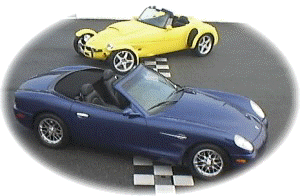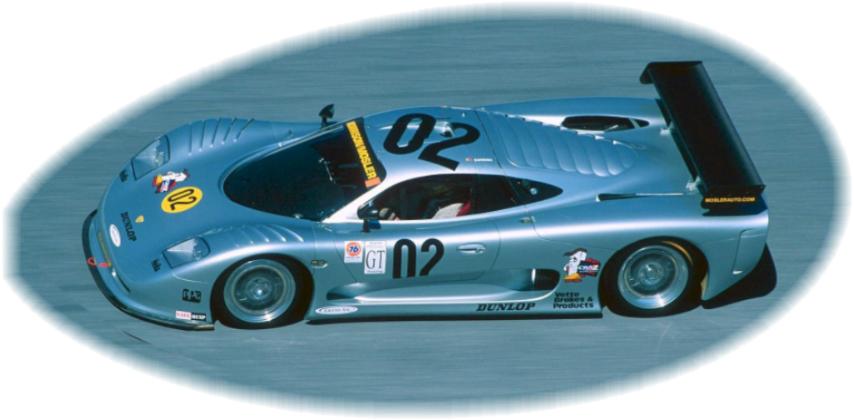Lightweight Construction
Thinking about lightweight cars? Here are some sources of info on composite and aluminum materials. The Aluminum Association has a page featuring The Use of Aluminum by Automakers, including aluminum intensive vehicles such as the production Lotus Elise, Panoz Roadster, Audi A8, and concept cars. The Matrix Plastics Company web site includes a very brief Introduction to Plastics Processing and summaries of the most widely used plastic molding/forming techniques. The Composite Materials Inc. site includes background on the common resin and fibers used in composite materials. It does not attempt to detail important construction topics such as molding, pre-preg, wet layup, vacuum bagging, autoclave curing, etc. A source of foam and balsa cores used in sandwich composites is Divinylcell International (DIAB).

The
Panoz
Roadster and Esperante convertible use superplastic-formed aluminum body
panels and large-section, extruded-aluminum frame members.
Superplastic forming uses high pressure air
to force heated sheet aluminum over a single surface mold.
The aluminum is hardened by the heat, and the process does
not create thin areas like hammer-forming.
Superform USA, the Riverside, California
branch of U.K.-based
Superform Aluminum
supplies body panels to Panoz.
Its main business is supplying formed panels to the aerospace
industry.
Panoz Roadster
chassis extrusions come from
Alumax
Extrusions.
At 2600 lbs, the Panoz cars are lighter than steel monocoques,
but are still 1000 lbs heavier than the Lotus Elise.
Part of the weight difference is the Ford 4.6 V-8 in the Panoz
versus a Rover K-series 1.8 liter four in the Lotus.
Even so, performance is comparable due to the Elise' lighter weight.
The
Lotus Elise
also uses aluminum extrusions and sheet, but its body is
fiberglass.
The Elise aluminum chassis is largely bonded (glued) whereas the Panoz is
mostly welded.
Elise extrusions and chassis are sourced from
Hydro Aluminum Extrusion
of Norway.
A bonded Aluminum chassis can be made lighter than a welded one. Because welding heats the extrusions, it requires heavier gauges, and results in a heavier chassis, which in turn requires a heavier structure to support the greater mass, and so on. Welding begets heavier; heavier begets heavier. With lightness as a goal, bonding is preferable.
Though aircraft have long used riveted bondings, the long term stability of bonding in road vehicles may still be an open question. There are also some practical limitations on where bonding can be applied. For example, high operating temperatures, which weakens bonds prevents the use of bonded structures near Elise' engine. Traditionally two part epoxies are used for structural bonding. GM currently uses Cyanoacrylates (super glues) to enhance the rigidity of spot the welded steel F-car (Camaro and Firebird) chassis. While this is not a bonded chassis, it's an interesting application of structural adhesives to improve a conventional, mass-produced, assembly-line vehicle. This use of adhesives is finding increasing acceptance in passenger car production.

Another interesting car to appear around February 2001 is the
Mosler MT900
Mosler's previous low-slung, mid-engined race/street cars were as
fast as they were hideously ugly.
MT900, styled by ex-GM Unigraphics designer Rod Trenne,
continues Mosler's use of composite sandwich chassis but with a
generically good looking supercar body. Where earlier Mosler cars
used boat-like foam core sandwiches, MT900 uses 1 inch
Aluminum honeycomb. Motivation is from a current Corvette engine mated
to an inverted Porsche gearbox. Both race and street versions
miss the 900 kg (2000 lb) target weight at 2200 and 2600 lbs
respectively, but performance is still outstanding with the
street version reaching 60 MPH (100 KM/H) in 3.5 seconds.
Mosler's racing version MT900R debuted February 2001 at the
Rolex 24-Hours
of Daytona under the Morrison Motorsports banner.
Perhaps the most interesting story is how the MT900 was created. Designed in Unigraphics software by Trenne, the data for body forms were sent over the Internet to UCAR Composites in Irvine, California. Trenne's data drove UCAR's toolmaking machines to produce a buck upon which carbon-fiber body panels were laid up back at Mosler. Car and Driver reports that the prototype was built for $500,000. Part of the reason for that relatively miniscule cost is that Unigraphics fronted employee Trenne's skills and the use of their $100 million software package in order to establish themselves as an automotive design service. Mosler reports that car went together cleanly. All seemed impressed with the ability to produce a tight, clean design in software. MT900 was Trenne's design from the beginning. A junior member of the Corvette C5 design team when GM crash tested an earlier Mosler, Trenne told Car and Driver he thought "all this guy needs is a good design." So in 1995 he approached Mosler with a design "to fit his engineering." Trenne contacted Unigraphics seeking funding and they turned the tables by hiring him and sponsoring MT900's design development to showcase their capabilities.
Mosler hopes to sell race and street versions of the car in the $120,000 to $160,000 range, though he feels the exotic car market is currently a bit flat. Perhaps so, but I feel the MT900 could sell better than his previous cars which look like they were styled by Captain Nemo's myopic half-brother. The previous cars were so ugly that Mosler seemed to have trouble giving them away. No one wants to be seen in an ugly car no matter how fast. The MT900 finally gets Mosler a car with looks to match its performance.